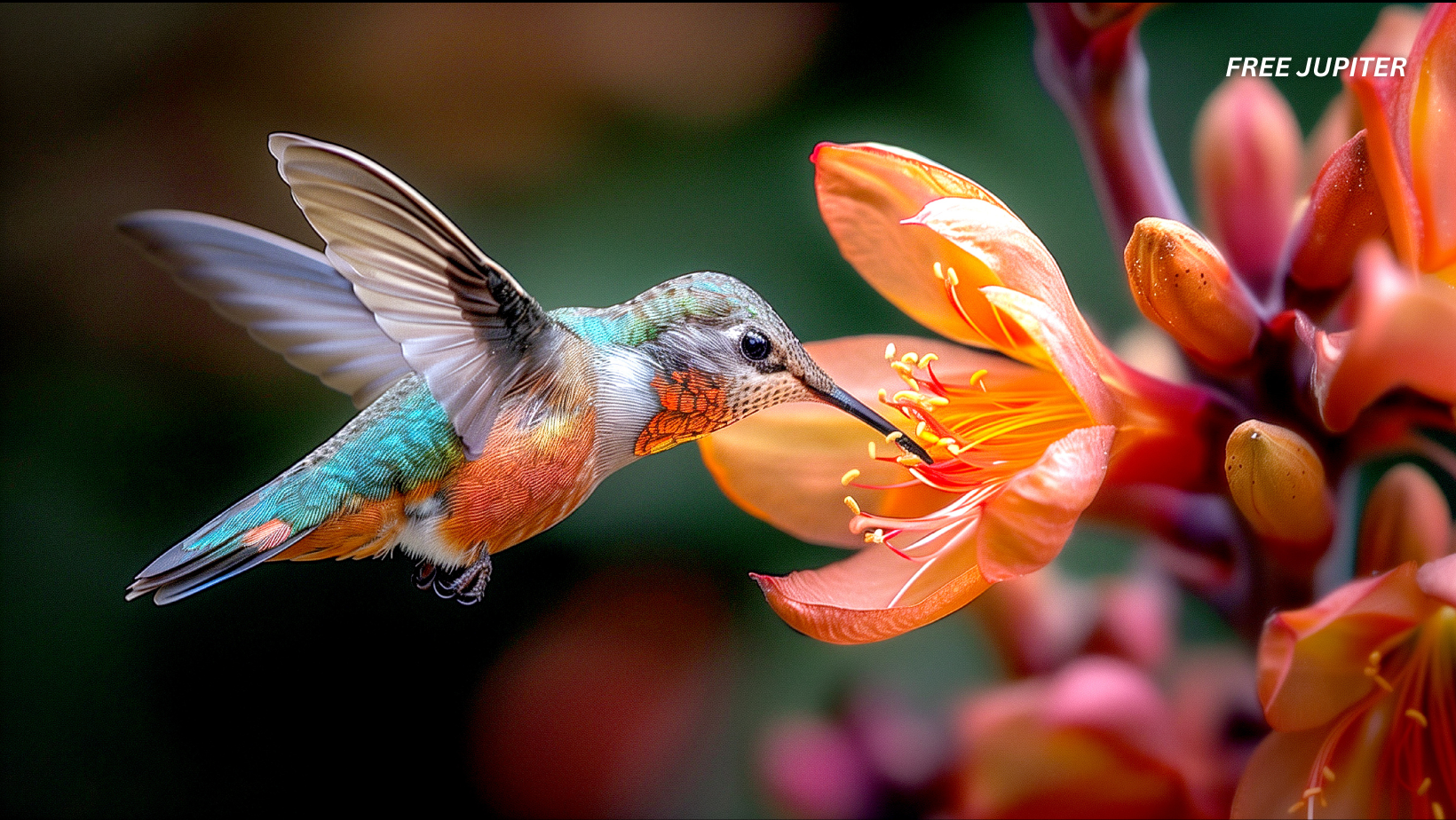Friendly Note: FreeJupiter.com shares general info for curious minds 🌟 Please fact-check all claims—and always check health matters with a professional 💙
By late summer, many gardens start to lose that lush, early-season glow. The roses may have had their first flush, spring bulbs are a distant memory, and some perennials are beginning to look a little weary. But August isn’t the end of the story—it’s a crucial time for both plants and wildlife, especially for hummingbirds embarking on one of nature’s most incredible journeys.
These tiny, jewel-colored birds are not just fluttering from one neighborhood to the next—they are gearing up for a migration that can span thousands of miles, often from North America all the way to Central or even South America. For a creature that weighs less than a teaspoon of sugar, this is an extraordinary feat. And like any traveler, they need rest stops and refueling stations along the way.
That’s where your garden comes in. By planting certain nectar-rich flowers in August, you can create a late-summer buffet for hummingbirds, giving them the energy they need to continue their journey. And the good news? Even though the season is winding down, it’s not too late to plant them now.
Why Late-Blooming Flowers Matter for Hummingbirds
Hummingbirds have an almost constant need for energy. Their wings beat anywhere from 50 to 80 times per second, and their tiny hearts can race at over 1,200 beats per minute when in flight. This means their fuel—primarily nectar—is used up quickly, and they must feed frequently, often visiting hundreds of flowers in a single day.
During migration, their energy needs are even higher. Late-blooming flowers provide an essential food source at a time when many other nectar plants have already faded. Without them, hummingbirds might struggle to find enough sustenance along their route.
And the benefit isn’t just for the birds. These same flowers often support bees, butterflies, and other pollinators, making your garden a lively and ecologically valuable space right through the end of summer.
Read more: Wildlife Experts Warn: Never Release These 17 Animals Into the Wild
The 7 August Planting Picks for Hummingbirds
Below is a detailed look at seven flowers that bloom late in the season, offer plenty of nectar, and are easy to grow—even if you’ve never considered yourself a gardener.
1. Coral Honeysuckle (Lonicera sempervirens)
Imagine a flower designed by nature specifically for hummingbirds—long, slender, and trumpet-shaped, almost like it’s holding out a nectar-filled cup. That’s coral honeysuckle. Its clusters of red to coral-colored blooms are a visual magnet, signaling to hummingbirds that dinner is served.
Why it’s great:
- Bloom Time: Spring through fall, with peak nectar availability in late summer.
- Care Needs: Full sun to part shade, average water, hardy in Zones 4 and up.
- Extra Benefit: Non-invasive compared to Japanese honeysuckle, and great for vertical gardening.
Coral honeysuckle is ideal for fences, trellises, or arbors, where it can climb gracefully and create a vibrant living wall. Once established, it’s quite low-maintenance, needing little more than occasional pruning to keep it tidy.
2. Valerian (Centranthus ruber)
Valerian is a survivor. It’s drought-tolerant, hardy, and happy in less-than-perfect soils. Its clusters of small, fragrant, pinkish-red flowers stand tall, making them easy for hummingbirds to spot while on the wing.
Why it’s great:
- Bloom Time: Late spring to early fall, often continuing into September with deadheading.
- Care Needs: Full sun, tolerates dry conditions, hardy to Zone 5.
- Extra Benefit: Also attracts butterflies and beneficial insects.
In the wild, valerian has been known to grow in rocky slopes, along roadsides, and in the cracks of old walls—proof that it’s not a fussy plant. For gardeners, this makes it a reliable late-summer choice that offers plenty of nectar without much effort.
3. Ironweed (Vernonia noveboracensis)
Ironweed earns its name from its tough stems and resilience. With its deep purple blooms, it’s a late-summer star that stands tall in the garden, often reaching heights of four to six feet.
Why it’s great:
- Bloom Time: August through September.
- Care Needs: Full sun, prefers moist but well-draining soil, hardy to Zone 4.
- Extra Benefit: Provides nectar for a wide range of pollinators, not just hummingbirds.
Because it blooms so late, ironweed is often one of the last abundant nectar sources before fall fully sets in. Planting it where you can see it from your porch or kitchen window lets you enjoy watching hummingbirds hover and dart around its purple clusters.
4. Goldenrod (Solidago spp.)
Goldenrod is often misunderstood—it’s frequently blamed for hay fever, but the real culprit is ragweed, which blooms at the same time. In reality, goldenrod is a pollinator powerhouse, lighting up the late-summer garden with tall spikes of golden-yellow flowers.
Why it’s great:
- Bloom Time: August through October.
- Care Needs: Full sun, adaptable to many soil types, hardy to Zone 3.
- Extra Benefit: Supports over 100 species of pollinators.
In a naturalized garden or meadow planting, goldenrod adds height and texture, often reaching up to six feet. For hummingbirds, it’s an easy-to-spot refueling station.
Read more: Scientists Say More Animals Are Conscious Than We Ever Imagined—Even Insects
5. Aster (Symphyotrichum spp.)
Asters are like the grand finale of the flower world, blooming just when you think the show is over. Their star-shaped flowers come in shades of purple, pink, and white, and they’re rich in nectar at a time when other plants are winding down.
Why it’s great:
- Bloom Time: Late summer into fall, sometimes as late as December in mild climates.
- Care Needs: Full sun, average soil, hardy to Zone 4.
- Extra Benefit: Provides late-season color and attracts butterflies.
New England asters, in particular, are favorites for migrating hummingbirds. Taller varieties may need staking, especially in windy or rainy conditions.
6. Pineapple Sage (Salvia elegans)
With its bright red flowers and tropical scent, pineapple sage is both a treat for hummingbirds and a sensory delight for gardeners. Crush a leaf, and you’ll release a burst of pineapple aroma.
Why it’s great:
- Bloom Time: Late summer to frost.
- Care Needs: Full sun, well-drained soil, hardy to Zone 8.
- Extra Benefit: Edible leaves and flowers for teas and garnishes.
It’s best suited to warm climates, but in cooler zones, it can be grown in large pots and overwintered indoors. By late August, its flower spikes become a favorite stop for southbound hummers.
7. Milkweed (Asclepias spp.)
Most people know milkweed as a host plant for monarch butterflies, but its nectar-rich blooms are just as valuable to hummingbirds.
Why it’s great:
- Bloom Time: Summer into early fall.
- Care Needs: Full sun, average soil, hardy to Zone 3.
- Extra Benefit: Supports multiple pollinator species, not just one.
Butterfly weed (Asclepias tuberosa) is particularly striking, with vivid orange flowers that can bloom into October. Milkweed’s sturdy stems and clustered blooms make it an accessible feeding platform for hummingbirds.
Extra Tips for Helping Hummingbirds in Late Summer
- Don’t cut back too early: Even fading or browned blooms may still contain nectar. Leaving them standing can give hummingbirds a final boost before they move on.
- Provide fresh water: Hummingbirds don’t just drink nectar—they also need water for bathing and drinking. A shallow birdbath with pebbles for perching can help.
- Avoid pesticides: Chemicals can harm both the birds and the insects they feed on. Opt for natural pest control methods.
- Plant in clusters: Grouping flowers together makes it easier for hummingbirds to find them and conserve energy while feeding.
Read more: Study Finds Female Frogs Literally Pretend to Be Dead to Avoid Mating With Males They Don’t Like
Why Your Garden Matters More Than You Think
It’s easy to assume that nature will take care of itself, but migration is a high-risk journey for hummingbirds. Loss of habitat, climate shifts, and reduced food sources all add pressure. A single garden—whether large or small—can act as a critical stopover point, offering the calories they need to survive the next leg of their journey.
By planting late-blooming flowers, you’re not just adding beauty to your yard—you’re playing a part in a much larger ecological story, one that spans continents and seasons. And as a bonus, you’ll have a vibrant, colorful garden when many others are fading into autumn dullness.










